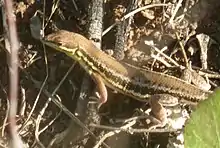Ichnotropis capensis
Ichnotropis capensis is a species of African lizard, which is native to the southern Afrotropics. It is the type species for the genus Ichnotropis, and is commonly called the Cape rough-scaled lizard due to them being found in southern Africa's Cape region. They are also called ornate rough-scaled lizard or Smith's rough-scaled sand lizard. The small lizards are terrestrial and occur in grassland, desert and brush areas of southern Africa.
| Cape rough-scaled lizard | |
|---|---|
 | |
| in Limpopo, South Africa | |
| Scientific classification | |
| Kingdom: | Animalia |
| Phylum: | Chordata |
| Class: | Reptilia |
| Order: | Squamata |
| Family: | Lacertidae |
| Genus: | Ichnotropis |
| Species: | I. capensis |
| Binomial name | |
| Ichnotropis capensis (Smith, 1838) | |
| Synonyms | |
|
Algyra capensis Smith, 1838[1] | |
Description
I. capensis are medium-sized lizards with slender bodies, long tails, and well developed legs.[2] Most of the specimens found are less than 76 mm long in snout–to-vent length (SVL) and share the general characteristics of its genus,[2] including the following:[2]
- Keeled or overlapping dorsal scales are present, and the head shields are smooth to slightly rough
- Subocular scales border the lip, and no collar is present
- Smooth or tubular lamellae are present under the toes, but the toes lack a serrated or fringed edge
- The cylindrical tail lacks a lateral fringe
I. capensis is notably distinct from the genus in that the hind legs do not reach the underarm of the forelimbs.[3] Adults have uniform grey and yellowish brown backs with white lateral stripes that may be bordered with dark black spots.[2] The juvenile has a pale grey and brown back with white lateral stripes.[2]
Races
There are two accepted races:[4]
- Ichnotropis capensis capensis (A.Smith, 1838)
- Ichnotropis capensis nigrescens Laurent, 1952
Habitat
It occurs in semi-arid shrub savannas of Africa,[5] where they seek shelter in soft soiled burrows, under rocks and brush. The species has been reported from South Africa, Namibia, Botswana, Zimbabwe, Mozambique, and Zambia.[4]
Biology
These lizards are insectivorous and feed on termites and other small insects.[2] They are active hunters during the day and many specimens have been found around termite mounds.[6]
Mating
The life expectancy is 13 to 14 months, and mating occurs in the spring with hatchlings appearing in late summer from October to December.[2] Females make an inclining burrow in soft soil 100 to 200 mm long and lay 3-9 eggs (6.5 mm x 9.5 mm).[2] The females may have up to two clutches in their lifetime.[2]
Taxonomy and evolution
Based on morphological evidence from the capensis species, southern African genus Ichnotropis and North American genus Psammodromus diverged from a common ancestor in the lineage of Lacerta lepida and Lacerta monticola during the Oligocene epoch (24 to 36 million years ago).[7]
Predators
It is recorded as prey of the shikra and secretarybird, both birds of prey that are native to Africa.[8][9] They may have other predators as well, as they are small lizards, but there is no evidence suggesting that they are endangered or hunted by indigenous people who live near their habitat. Apparently hunting does not harm them sufficiently to be considered threatened.
References
- Smith, A. (1838) - Contributions to the Natural History of Southern Africa. Art. VIII. - Magazine of natural history, London, 2 (14): 92-94.
- Branch, William (1998). Field guide to snakes and other reptiles of Southern Africa (3rd ed.). Cape Town, Africa: Stuik Publishers. pp. 160–162. ISBN 1868720403.
- Allen, Joel (1919)Bulletin of the American Museum of Natural History, Vol. 39, American Museum of Natural History, pp. 509
- Ichnotropis capensis from the Database online
- Kennedy, A., Marais, J., Bauer, M., Lewis, P., and Thie, Monte. (2014) Effect of Fire on the Herpetofauna of the Koanaka Hills, Ngamiland, Botswana. Check List. 8. pp. 666–674
- Fleming, P., and Loveridge, John. (2003). Miombo woodland termite mounds: resource islands for small vertebrates?. Journal of Zoology. 259. pp. 161–168.
- Busack, Stephan & Maxson, Linda. (1986) Molecular relationships among Iberian, Moroccan, and South African lacertid lizards (Reptilia: Lacertidae). Amphibia-Reptilia 8. pp. 383-392.
- Biodiversity Explorer online, Ichnotropis capensis
- Biodiversity Explorer online, Sagittarius serpentarius